Total lunar eclipse before dawn on April 4th
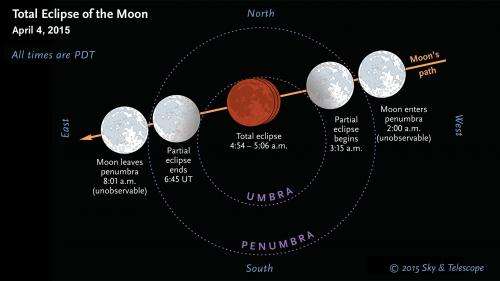
An unusually brief total eclipse of the Moon will be visible before dawn this Saturday, April 4th, from western North America. The eclipse happens on Saturday evening for Australia and East Asia.
Whenever the Sun, Earth, and Moon form a near-perfect lineup in space, the Moon glides through Earth's deepest shadow—creating a total lunar eclipse. Earth's shadow gradually intrudes across the face of the full Moon until the entire lunar disk glows dim orange or red. Then events undo themselves in reverse order, until the Moon returns to full brilliance. This dramatic sequence can be seen on Saturday, April 4th—if you're looking from the right part of the world at the right time.
As was the case last October 8th, this weekend's lunar eclipse favors westerners in the U.S. and Canada. And once again most will need to look low in the west as dawn brightens—lower, in fact, than last time.
The timetable below tells what to expect at your location and when. (See also the diagram and map at the end.) Weather permitting, those near the West Coast will have the best view, with the total phase of the eclipse happening when the Moon is still fairly high in a dark sky before dawn even begins. Skywatchers in the Plains states will find dawn growing bright and the Moon sinking low in the west around totality. For the eastern half of North America, the Moon sets and the Sun rises before the total phase even begins. New England misses even the earliest partial phase.
Meanwhile, from Hawai'i or New Zealand, the eclipse happens deep in the night and high in the sky. For Australia, Japan, China, and Southeast Asia, the total eclipse occurs on the evening of April 4th.
Unlike a total solar eclipse, which can only be seen from a narrow path across Earth's surface, a lunar eclipse can be watched from the entire half of the world facing the Moon at the time.
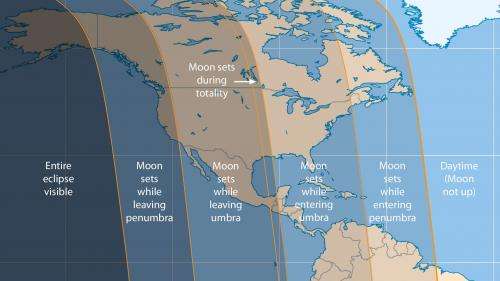
What to Look For
You only need your eyes to see the drama unfold during a total lunar eclipse, though the view is enhanced when seen through binoculars or a small backyard telescope.
April 4th's total eclipse is unusual in that the Moon just barely skims through Earth's inner shadow, the umbra, and then only briefly. Because of this, the Moon's northeastern edge will remain much brighter than the deep red that is typically seen all across the eclipsed Moon's face.
The first sign that an eclipse is under way comes when the Moon is about halfway across Earth's pale outer fringe of shadow, the penumbra. A slight darkening on the Moon's left or lower-left side becomes stronger as the lunar disk moves deeper into the penumbra.
The partial eclipse that follows is more dramatic, because the Moon is partly within the umbra, where no sunlight directly reaches the lunar surface.
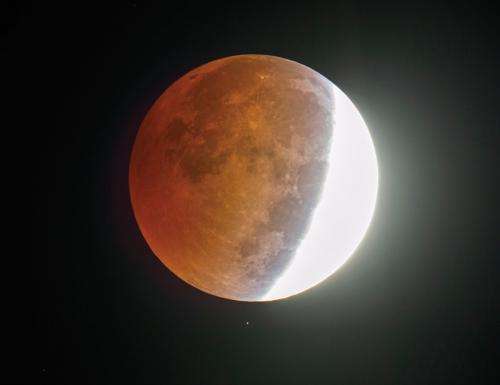
Totality comes about 1½ hours after the partial phases begin. However, the edge of the umbra is not sharp, due to Earth's semitransparent atmosphere, so there is some uncertainty on exactly how to define the umbra's edge. The U.S. Naval Observatory, the source used by Sky & Telescope, calculates that totality will last a bit more than 12 minutes, whereas some other sources say just 9 minutes.
In any case, during totality most of the Moon will likely glow some intense shade of orange or red—even though it is completely immersed in the umbra. This light comes from all the sunrises and sunsets around the Earth's rim at that moment: sunlight that has skimmed through Earth's atmosphere and been refracted (bent) by the atmosphere into the umbra.
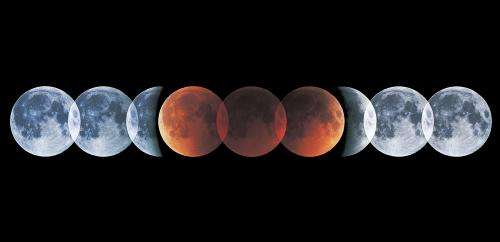
After totality ends, the Moon's edge emerges into sunlight, and the sequence of partial and penumbral events plays out in reverse order. It will take 3½ hours from when the partial phase begins until it ends. About 45 minutes after that, the Moon appears fully bright white again and nothing unusual remains.
This eclipse comes just two weeks after the total solar eclipse on March 20th, which occurred at new Moon and was seen from parts of the North Atlantic and Arctic oceans. It is also the third of four total lunar eclipses during 2014–15 spaced about six months apart; the fourth will occur on the evening of September 27, 2015, for all of the Americas except northwestern Canada and Alaska. Such "eclipse tetrads" are not very common—the last one occurred a decade ago, but the next won't begin until 2032.
-
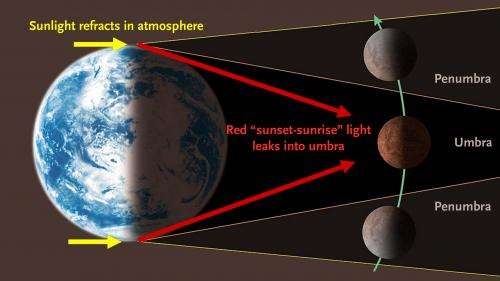
If Earth had no atmosphere, the Moon would look completely black during a total lunar eclipse. However, a little of the Sun's red light refracts through the atmosphere and into Earth's umbra, coloring the lunar disk during totality. (Not shown to scale.) Credit: Sky & Telescope -
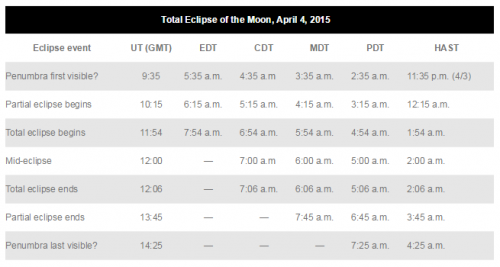
Provided by Sky & Telescope





















